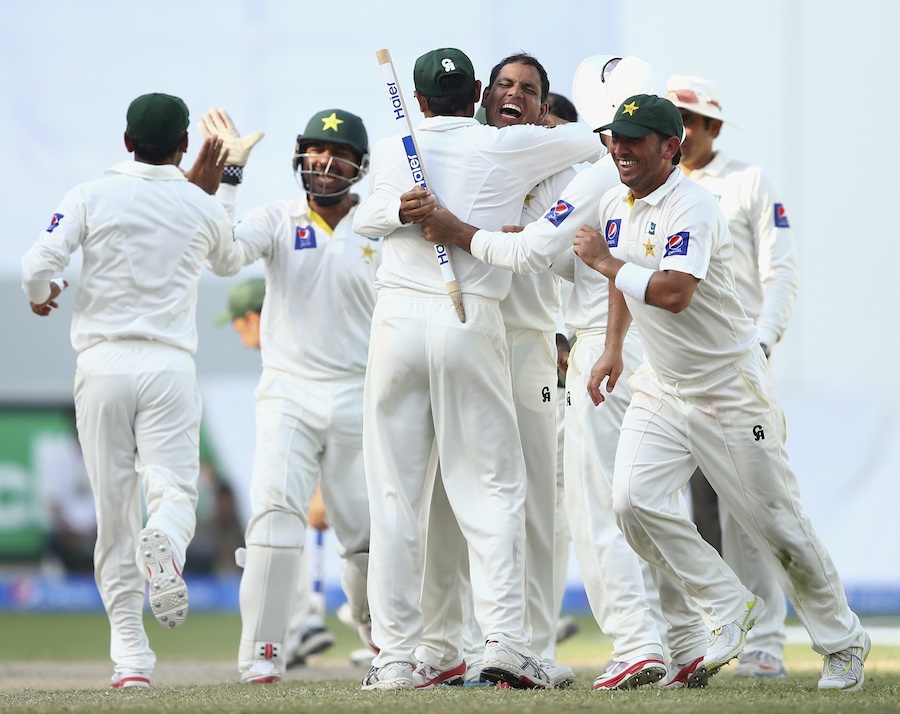Pakistan have recorded a 221-run victory over Australia in their first Test in Dubai after bowling the tourists out for 216
Pakistan 454 (Sarfraz 109, Younis 106) and 286 for 2 dec (Shehzad 131, Younis 103*) beat Australia 303 (Warner 133) and 216 (Johnson 61, Smith 55, Babar 5-74, Yasir 4-50) by 221 runs
Younis becomes Pakistan’s leading century-maker
Not since 1994 have Pakistan led Australia in a Test series. A telling 221-run victory in Dubai means that Misbah-ul-Haq’s wonderfully resilient team are now a chance of breaking an identical 20-year drought between series wins over the same opponent.

Pakistan proved far more skilful, resourceful and focused than Australia, who missed Ryan Harris and Shane Watson rather more than Misbah’s men suffered for the absence of Saeed Ajmal and Junaid Khan. The Australia lower order battled manfully but could not erase the sins of the top six, who apart from David Warner failed utterly in conditions that have become an all too familiar source of trouble.
Zulfiqar Babar and Yasir Shah were the fourth-innings architects of Pakistan’s triumph, their expertise and subtlety providing a reminder that most spin bowlers are forged in first-class cricket and are invariably better for experience. By contrast, Michael Clarke’s team have an array of problems to address, not least the increasing comfort with which Pakistan’s batsmen played his bowling attack across the Test.
The day was not without some moments of doubt for Pakistan, not least when they spurned a quartet of chances during the afternoon session, though Babar and Yasir continued to bowl diligently and well on the worn pitch. But Pakistan always had time to spare, and Mitchell Johnson’s line-ball stumping went their way in the ascendant much as it often did for Australia during their years of dominance.
Chris Rogers and Steven Smith had begun with determined intentions, and as happened in the first innings and again on the fourth evening an Australia pair started firmly. Despite some extravagant turn for Yasir and reverse swing in both directions from Rahat Ali, they made it through to morning drinks.
Misbah-ul-Haq threw the ball to Imran Khan, who proceeded to work on bending the ball in the manner of his namesake, albeit at a lesser pace. Rogers had kept out many a threatening delivery and was the only Australian to face more than 100 balls in each innings. But he was late in recognising Imran’s inswinger, and to the sound of Pakistani roars his middle stump was tilted back.
Mitchell Marsh is a young man who will learn from this experience, but his defensive skills against spin were found wanting in each innings. Too crooked across a straight delivery from Babar on day three, he was now too hard-handed against the same bowler, shooting the ball off the bat straight into the lap of silly point.
Though raised on slower, spinning pitches in New South Wales, Brad Haddin’s method has never been particularly suited to the natural variations of subcontinental pitches. His firm hands and penchant for driving at the line of the ball can look imperious, but here it was inadequate as a Babar straight ball zipped between bat and pad to strike leg stump.
All the while Smith fought and fidgeted, but gradually lost momentum as wickets began to fall. Not a single boundary was hit in the morning session. There was more intent when Smith and Johnson resumed in the afternoon, their efforts to score a little more often spreading Misbah’s field.
After a while, the fifty stand arrived, and Pakistan began to show signs of tension. No fewer than four chances went down from the bowling of Babar – Smith surviving a stumping chance on 37, then dropped by Misbah on 44, albeit from a fiercely struck cover drive. Johnson’s patience was tested, and when he was on 23, Ahmed Shehzad at deep midwicket turfed a slog-sweep that should have been taken. When Johnson was on 25, Yasir Shah misjudged a top-edged Johnson sweep at backward square leg and could only get one hand to it.
Smith passed 50 and could glimpse tea, but Yasir’s return to the attack brought a half-volleyed flick to short leg. It was a blur of pitch, ball and bat, but replays confirmed a fair catch and Smith trudged off. Johnson and Siddle fought their way through the second new ball, and maintained faint hope at tea.
Few alarms were raised in the early minutes of the evening session, Australia daring to hope they might emulate some of the escapes made by South Africa and England in earlier years when they showed the best teams are as capable of wriggling to a draw as galloping to a win.
But Yasir found some variety out of the rough to Johnson, who had begun playing in a slightly more defensive vein. A review for an lbw when he padded up was rejected, but a straighter delivery in the same over beat the outside edge and had Sarfraz Ahmed screeching in the sort of stumping appeal shared by quick-witted wicketkeepers.
Replays seemed to show some of Johnson’s boot behind the line, but the third umpire Nigel Llong concluded that none of it was grounded. His decision was the cue for Pakistani jubilation – and a thunderous glare from Darren Lehmann in Australia’s viewing area. Johnson departed glumly.
That moment more or less finished the match. Siddle eluded an lbw appeal and review by Babar the following over, but a hearty inside edge gave the left-arm spinner a deserved five-wicket haul in his next. Pakistan now cannot lose the series. Australia, Ashes and all, cannot win it.
The Report by Daniel Brettig at Cricinfo
The second Test begins in Abu Dhabi on Thursday.




